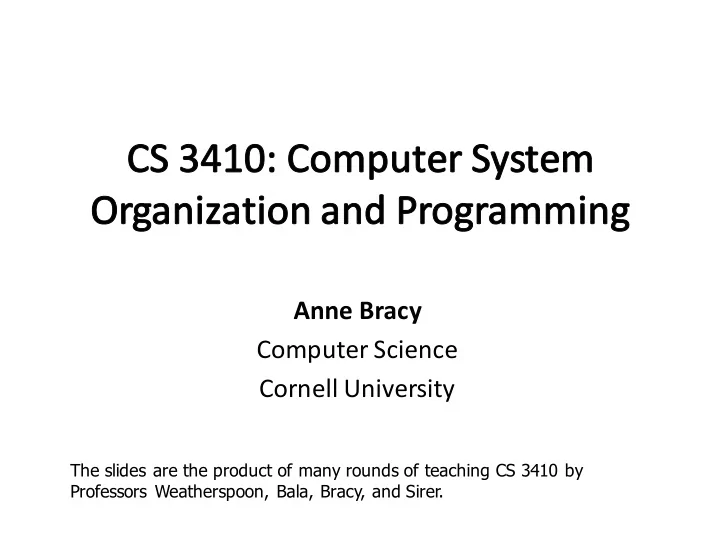

Anne Bracy Computer Science Cornell University The slides are the product of many rounds of teaching CS 3410 by Professors Weatherspoon, Bala, Bracy, and Sirer.
“Sometimes it is the people that no one imagines anything of who do the things that no one can imagine” --quote from the movie The Imitation Game
“Can machines think?” -- Alan Turing, 1950 Computing Machinery and Intelligence
The Bombe used by the Allies to Enigma machine break the German Used by the Germans during Enigma machine during World War II to encrypt and World War II exchange secret messages
Turing Machine Alan Turing 1936 = abstract model for CPU that can simulate any algorithm
Demographics Introduce yourself to the people next to you “Sometimes it is the people that no one imagines anything of who do the things that no one can imagine.” Turing Award Winners?
Understand the HW / SW interface software • How a processor works • How a computer is organized Establish a foundation for building applications • How to write a good program – Good = correct, fast, and secure • How to understand where the world is going Understand technology (past, present, future)
#include <stdio.h> int main() { printf("Hello world!\n"); return 0; } How does it work? I’m glad you asked… 15 weeks later and you’ll know! “I know Kung Fu.”
int x = 10; C x = 2 * x + 15; r0 = 0 compiler r5 = r0 + 10 MIPS addi r5, r0, 10 r5 = r5 * 2 assembly muli r5, r5, 2 r5 = r5 + 15 addi r5, r5, 15 language assembler op = addi r0 r5 10 MIPS 00100000000001010000000000001010 00000000000001010010100001000000 machine 00100000101001010000000000001111 language op = addi r5 r5 15 Everything is a number!
0 inst 10 alu memory register file r5 r0 32 10 2 32 5 5 5 00 pc new pc control calculation 00: addi r5, r0, 10 04: muli r5, r5, 2 08: addi r5, r5, 15
ISA • abstract interface between hardware and the lowest level software • user portion of the instruction set plus the operating system interfaces used by application programmers
Application Operating System Compiler Firmware Instruction Set Architecture Memory Instr. Set Proc. I/O system system Datapath & Control Digital Design Circuit Design
Application Operating System Compiler Firmware Instruction Set Architecture Memory Instr. Set Proc. I/O system system Datapath & Control Digital Design Circuit Design
Electrical Switch • On/Off • Binary Transistor The first transistor on a workbench at AT&T Bell Labs in 1947 Transistors
1965 • # of transistors integrated on a die doubles every 18-24 months ( i.e., grows exponentially with time) Amazingly visionary 2300 transistors, 1 MHz clock (Intel 4004) - 1971 • 16 Million transistors (Ultra Sparc III) • 42 Million transistors, 2 GHz clock (Intel Xeon) – 2001 • 55 Million transistors, 3 GHz, 130nm technology, 250mm 2 die (Intel • Pentium 4) – 2004 290+ Million transistors, 3 GHz (Intel Core 2 Duo) – 2007 • 721 Million transistors, 2 GHz (Nehalem) - 2009 • 1.4 Billion transistors, 3.4 GHz Intel Haswell (Quad core) – 2013 •
Intel Pentium 4/3000 Intel Xeon/2000 DEC Alpha 21264A/667 DEC Alpha 5/500 DEC Alpha 21264/600 DEC Alpha 5/300 IBM POWER 100 DEC Alpha 4/266 HP 9000/750 DEC AXP/500 IBM RS6000 MIPS M2000 SUN-4/260 MIPS M/120
http://techguru3d.com/4th-gen-intel-haswell-processors-architecture-and-lineup/ • The first transistor • An Intel Haswell • One workbench at AT&T Bell Labs • 1.4 billion transistors • 1947 • 177 square millimeters • Bardeen, Brattain, and Shockley • Four processing cores What are we doing with all these transistors?
Why take this course? • Basic knowledge needed for all other areas of CS: operating systems, compilers, ... • Levels are not independent hardware design ↔ software design ↔ performance • Crossing boundaries is hard but important device drivers • Good design techniques abstraction, layering, pipelining, parallel vs. serial, ... • Understand where the world is going The Mysteries of Computing will be revealed!
Recommend
More recommend